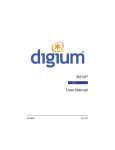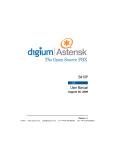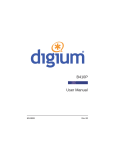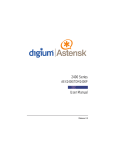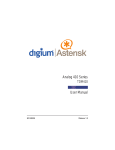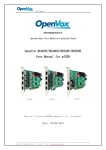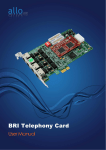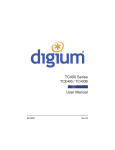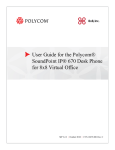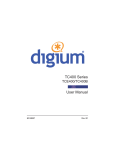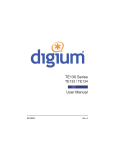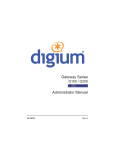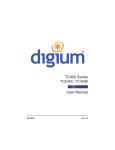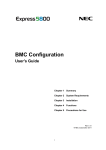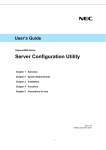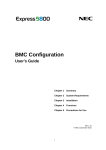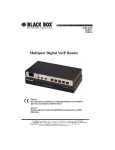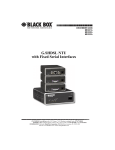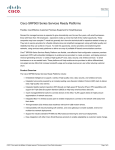Download B410P User Manual
Transcript
B410P User Manual Release 1.3 Digium, Inc. 445 Jan Davis Drive Huntsville, AL 35806 United States Main Number: 1.256.428.6000 Tech Support: 1.256.428.6161 U.S. Toll Free: 1.877.344.4861 Sales: 1.256.428.6262 www.digium.com www.asterisk.org www.asterisknow.org © Digium, Inc. 2007 All rights reserved. No part of this publication may be copied, distributed, transmitted, transcribed, stored in a retrieval system, or translated into any human or computer language without the prior written permission of Digium, Inc. Digium, Inc. has made every effort to ensure that the instructions contained in this document are adequate and error free. The manufacturer will, if necessary, explain issues which may not be covered by this documentation. The manufacturer’s liability for any errors in the documents is limited to the correction of errors and the aforementioned advisory services. This document has been prepared for use by professional and properly trained personnel, and the customer assumes full responsibility when using it. Adobe and Acrobat are registered trademarks, and Acrobat Reader is a trademark of Adobe Systems Incorporated. Asterisk and Digium are registered trademarks and Asterisk Business Edition, AsteriskNOW, AsteriskGUI, and Asterisk Appliance are trademarks of Digium, Inc. Any other trademarks mentioned in the document are the property of their respective owners. Release 1.3 Digium, Inc. Page 2 Safety Certification and Agency Approvals Safety: IEC 60950-1:2001 First Edition AS/NZS 60950 Telecom: AS/ACIF S031 PTC 220 TBR3 TBR4 November 1995 as amended by TBR4/A1 December 1997 Emissions: EN 55022:1998 Class B / EN 55022:1998 Class B Radiated and Conducted EN 55024:1998 / IEC 61000 Immunity: EN55024 ITE, EN61000 Telepermit Notes: PTC General Warning The grant of a Telepermit for any item of terminal equipment indicates only that Telecom has accepted that the item complies with minimum conditions for connection to its network. It indicates no endorsement of the product by Telecom, nor does it provide any sort of warranty. Above all, it provides no assurance that any item will work correctly in all respects with another item of Telepermitted equipment of a different make Release 1.3 Digium, Inc. Page 3 or model, nor does it imply that any product is compatible with all of Telecom's network services. The Digium B410P Quad BRI ISDN PCI Card has not been Telepermitted for use as an IP PSTN Gateway, although in some people’s minds the fact that it has a Telepermit is sufficient for all uses. Therefore use Telepermitted IP telephones when connecting private networks to the PSTN through this Digium B410P Quad BRI ISDN PCI Card. Loudness ratings to and from the PSTN must not be made to comply with Telecom’s specifications by adjusting levels at the gateway. Use of Telepermitted Interfaces for Connecting to the Telecom Network All interfaces connecting to the Telecom network from private IP voice and data networks must be covered by a Telepermit in the PTC220 range. This Telepermit range shows that the interface complies with the technical requirements of the PTC220 specification available from the Telepermit website. Echo Cancellation Echo cancellers are not normally required in the Telecom PSTN because geographic delays are acceptable where CPE return loss is maintained within Telepermit limits. However, those private networks making use of Voice over IP technology are required to provide echo cancellation for all voice calls. The combined effect of audio / VoIP conversion delay and IP routing delay can cause an echo cancellation time of 64 mS to be required. Release 1.3 Digium, Inc. Page 4 Introduction to B410P Documentation This manual contains product information for the B410P card. Be sure to refer to any supplementary documents or release notes that were shipped with your equipment. The manual is organized in the following manner: Chapter/ Appendix Title Description 1 Overview Identifies the features of your card. This chapter covers applications and uses of the B410P in the real world. 2 Card Installation Provides instructions for installing the card in your PC, acquiring correct drivers, and checking device compatibility. 3 Configuration Provides steps for configuring and verifying the install of your B410P was successful. 4 Troubleshooting Explains resolutions to common problems and frequently asked questions pertaining to card installation and usage. A Pin Assignments Lists the connectors and pin assignments. B Specifications Details card specifications. C Glossary and Acronyms Defines terms related to this product. Release 1.3 Digium, Inc. Page 5 Symbol Definitions Caution statements indicate a condition where damage to the unit or its configuration could occur if operational procedures are not followed. To reduce the risk of damage or injury, follow all steps or procedures as instructed. The ESD symbol indicates electrostatic sensitive devices. Observe precautions for handling devices. Wear a properly grounded electrostatic discharge (ESD) wrist strap while handling the device. The Electrical Hazard Symbol indicates a possibility of electrical shock when operating this unit in certain situations. To reduce the risk of damage or injury, follow all steps or procedures as instructed. Release 1.3 Digium, Inc. Page 6 Important Safety Instructions User Cautions Servicing. Do not attempt to service this card unless specifically instructed to do so. Do not attempt to remove the card from your equipment while power is present. Refer servicing to qualified service personnel. Water and Moisture. Do not spill liquids on this unit. Do not operate this equipment in a wet environment. Heat. Do not operate or store this product near heat sources such as radiators, air ducts, areas subject to direct, intense sunlight, or other products that produce heat. Static Electricity. To reduce the risk of damaging the unit or your equipment, do not attempt to open the enclosure or gain access to areas where you are not instructed to do so. Refer servicing to qualified service personnel. Save these instructions for future reference. Release 1.3 Digium, Inc. Page 7 TABLE OF CONTENTS Chapter 1 Overview . . . . . . . . . . . . . . . . . . . . . . . . . . . . . . . . . . . . . . . . . . . . . . . 12 What is Asterisk®? . . . . . . . . . . . . . . . . . . . . . . . . . . . . . . . . . . . . . 12 Asterisk as a Switch (PBX) . . . . . . . . . . . . . . . . . . . . . . . . . . . . . . . 13 Asterisk as a Gateway . . . . . . . . . . . . . . . . . . . . . . . . . . . . . . . . . . 13 Asterisk in the Call Center . . . . . . . . . . . . . . . . . . . . . . . . . . . . . . . 14 Asterisk in the Network . . . . . . . . . . . . . . . . . . . . . . . . . . . . . . . . . . 14 Asterisk Everywhere . . . . . . . . . . . . . . . . . . . . . . . . . . . . . . . . . . . . 14 Chapter 2 Card Installation . . . . . . . . . . . . . . . . . . . . . . . . . . . . . . . . . . . . . . . . . 15 Unpacking the Card . . . . . . . . . . . . . . . . . . . . . . . . . . . . . . . . . . . . . 15 Inspecting the Shipment . . . . . . . . . . . . . . . . . . . . . . . . . . . . . . . . .16 Identifying Communication Ports . . . . . . . . . . . . . . . . . . . . . . . . . . 16 Selecting NT or TE Mode . . . . . . . . . . . . . . . . . . . . . . . . . . . . . . . . 18 Terminating the NT Mode Line . . . . . . . . . . . . . . . . . . . . . . . . . . . . 19 Installing the Hardware . . . . . . . . . . . . . . . . . . . . . . . . . . . . . . . . . . 20 Installing the Software . . . . . . . . . . . . . . . . . . . . . . . . . . . . . . . . . . . 22 Chapter 3 Configuration . . . . . . . . . . . . . . . . . . . . . . . . . . . . . . . . . . . . . . . . . . . . 25 Configure the driver . . . . . . . . . . . . . . . . . . . . . . . . . . . . . . . . . . . .25 Verify the previous step . . . . . . . . . . . . . . . . . . . . . . . . . . . . . . . . . 25 Verify the card was found . . . . . . . . . . . . . . . . . . . . . . . . . . . . . . . . 25 Release 1.3 Digium, Inc. Page 8 Table Of Contents Configure the interface to Asterisk . . . . . . . . . . . . . . . . . . . . . . . . . 26 Enabling Echo Cancellation . . . . . . . . . . . . . . . . . . . . . . . . . . . . . . 27 Verify all the above steps . . . . . . . . . . . . . . . . . . . . . . . . . . . . . . . . 27 Chapter 4 Troubleshooting . . . . . . . . . . . . . . . . . . . . . . . . . . . . . . . . . . . . . . . . . 28 Appendix A Pin Assignments . . . . . . . . . . . . . . . . . . . . . . . . . . . . . . . . . . . . . . . . . 32 Appendix B Specifications . . . . . . . . . . . . . . . . . . . . . . . . . . . . . . . . . . . . . . . . . . . 34 Appendix C Glossary and Acronyms . . . . . . . . . . . . . . . . . . . . . . . . . . . . . . . . . . . 36 Release 1.3 Digium, Inc. Page 9 List of Figures Figure 1: Figure 2: Figure 3: Figure 4: Figure 5: Figure 6: Release 1.3 Sample Application . . . . . . . . . . . . . . . . . . . . . . . . . .12 B410P Card . . . . . . . . . . . . . . . . . . . . . . . . . . . . . . . 17 NT and TE Mode Jumper Positions . . . . . . . . . . . . . 18 NT Termination Switches . . . . . . . . . . . . . . . . . . . . . 19 Jumpers Reserved for Future Use . . . . . . . . . . . . . . 20 Insert the Card . . . . . . . . . . . . . . . . . . . . . . . . . . . . .21 Digium, Inc. Page 10 List of Tables Table A-1: Table B-2: Release 1.3 RJ45 ISDN BRI S/T Port Connector . . . . . . . . . . . . . 32 Maximum Power Consumption . . . . . . . . . . . . . . . . .35 Digium, Inc. Page 11 Chapter 1 Overview The Digium B410P is a four port BRI line termination card, compatible with Euro-ISDN. It is capable of serving as Terminal Equipment (TE) or as a Network Termination (NT) device. When configured as an NT device, it is the source of BRI lines as shown in Figure 1. The B410P can also improve voice quality in environments where software echo cancellation is not sufficient with hardware echo cancellation on board. Note: The B410P does not support North American BRI. ISDN Phones 3 NT PORTS 1 TE ISDN S/T NT 1 BRI PSTN Figure 1: Sample Application What is Asterisk®? Asterisk is the world’s leading open source telephony engine and tool kit. Offering flexibility unheard of in the world of proprietary communications, Asterisk empowers developers and integrators to create Release 1.3 Digium, Inc. Page 12 Chapter 1: Overview advanced communication solutions...for free. Asterisk® is released as open source under the GNU General Public License (GPL), and it is available for download free of charge. Asterisk® is the most popular open source software available, with the Asterisk Community being the top influencer in VoIP. Asterisk as a Switch (PBX) Asterisk can be configured as the core of an IP or hybrid PBX, switching calls, managing routes, enabling features, and connecting callers with the outside world over IP, analog (POTS), and digital (T1/E1) connections. Asterisk runs on a wide variety of operating systems including Linux, Mac OS X, OpenBSD, FreeBSD and Sun Solaris and provides all of the features you would expect from a PBX including many advanced features that are often associated with high end (and high cost) proprietary PBXs. Asterisk's architecture is designed for maximum flexibility and supports Voice over IP in many protocols, and can interoperate with almost all standards-based telephony equipment using relatively inexpensive hardware. Asterisk as a Gateway It can also be built out as the heart of a media gateway, bridging the legacy PSTN to the expanding world of IP telephony. Asterisk’s modular architecture allows it to convert between a wide range of communications protocols and media codecs. Asterisk as a Feature/Media Server Need an IVR? Asterisk’s got you covered. How about a conference bridge? Yep. It’s in there. What about an automated attendant? Asterisk Release 1.3 Digium, Inc. Page 13 Chapter 1: Overview does that too. How about a replacement for your aging legacy voicemail system? Can do. Unified messaging? No problem. Need a telephony interface for your web site? Ok. Asterisk in the Call Center Asterisk has been adopted by call centers around the world based on its flexibility. Call center and contact center developers have built complete ACD systems based on Asterisk. Asterisk has also added new life to existing call center solutions by adding remote IP agent capabilities, advanced skills-based routing, predictive and bulk dialing, and more. Asterisk in the Network Internet Telephony Service Providers (ITSPs), competitive local exchange carriers (CLECS) and even first-tier incumbents have discovered the power of open source communications with Asterisk. Feature servers, hosted services clusters, voicemail systems, pre-paid calling solutions, all based on Asterisk have helped reduce costs and enabled flexibility. Asterisk Everywhere Asterisk has become the basis for thousands of communications solutions. If you need to communicate, Asterisk is your answer. For more information on Asterisk visit http://www.asterisk.org or http:// www.digium.com. Release 1.3 Digium, Inc. Page 14 Chapter 2 Card Installation This chapter provides the following information: Unpacking the Card on page 15 Inspecting the Shipment on page 16 Identifying Communication Ports on page 16 Selecting NT or TE Mode on page 18 Terminating the NT Mode Line on page 19 Installing the Hardware on page 20 Installing the Software on page 22 Unpacking the Card When you unpack your card, carefully inspect it for any damage that may have occurred in shipment. If damage is suspected, file a claim with the carrier and contact your reseller from which the card was purchased, or Digium Technical Support (+1.256.428.6161). Keep the original shipping container to use for future shipment or proof of damage during shipment. Note: Only qualified service personnel should install the card. Users should not attempt to perform this function themselves. Release 1.3 Digium, Inc. Page 15 Chapter 2: Card Installation Inspecting the Shipment The following items are included in shipment of the B410P: B410P card Identifying Communication Ports The B410P card has four RJ45 ports and four status LEDs. The ports are used for connecting Basic Rate ISDN (BRI) lines. Each port can be configured as either TE or NT operation. The ports are numbered in sequence from one to four. The top port is Port 1 and the bottom port is Port 4. See Figure 2 on page 17 for appropriate identification of these ports. Note: It is important to know which type of BRI line each port is configured for, either TE or NT. You will need this information during the Asterisk configuration. Each RJ45 port is accompanied by a status LED. The status LEDs can indicate the following: Green - Card is in-sync with the far end. Yellow - Card is synchronizing. Red - Card is not seeing far end, circuit is not up, or cable is bad. Page 16 Digium, Inc. Release 1.3 Chapter 2: Card Installation Ports 1 Status LEDs 2 3 4 Keyed for 3.3 or 5 volt PCI Figure 2: B410P Card Release 1.3 Digium, Inc. Page 17 Chapter 2: Card Installation Selecting NT or TE Mode There is a 5-position jumper on the board for each port to select between NT and TE mode. This must be set before installing the card. Each of the four ports can be set for TE or NT mode independently. This eliminates the need to use a crossover cable. Place the jumper on the left side of the connector for NT mode, or place it on the right side for TE mode as shown in Figure 3. The default setting is TE mode. Notice in Figure 5 on page 20 there are an additional set of jumpers which are reserved for future use. These are not to be used at this time. There is a risk of electrical shock due to lightning when this device is utilized in TE mode. Take safety precautions when using the card in this manner. Note: Be careful when changing the jumper position. Figure 3: NT and TE Mode Jumper Positions Page 18 Digium, Inc. Release 1.3 Chapter 2: Card Installation Terminating the NT Mode Line There are DIP switches for each port used to add a 100 ohm termination when the B410P is in NT mode. This switch should only be turned on in those instances where a BRI is daisy-chained and terminated on the B410P in NT mode. See Figure 4 for a detailed illustration of this setting. This switch must not be turned on in TE mode. The default setting is Off. Caution. Only qualified service personnel should continue with hardware installation and configuration of the B410P card. Users should not attempt to perform these functions themselves. /. /. .4-ODE WITHOHM TERMINATION /. /&& .4-ODEWITHOUT OHMTERMINATION /. /&& 4%-ODEWITHOUT OHMTERMINATION This diagram illustrates the DIP switches that control resistance. 4HISDIAGRAMILLUSTRATESTHEJUMPERSTHATCONTROLRESISTANCE)N4% InMODETHEJUMPERSARETOREMAINOFF)N.4MODETHEJUMPERS TE mode, the switches are to remain off. In NT mode, the switches may be turned on when 100ohm resistance is required. MAYBETURNEDONWHENOHMRESISTANCEISREQUIRED Figure 4: NT Termination Switches Release 1.3 Digium, Inc. Page 19 Chapter 2: Card Installation ./453%$ 2ESERVEDFOR FUTUREUSE $EFAULT/0%. 4HISDIAGRAMILLUSTRATESJUMPERSTHATARERESERVEDFORFUTUREUSE Figure 5: Jumpers Reserved for Future Use Installing the Hardware 1. Now that you are acquainted with the card, power down your computer and unplug it from its power source. 2. Attach a static strap to your wrist and open the case. 3. Check the NT or TE mode jumper setting to ensure it matches your equipment configuration. 4. Remove the bracket place holder and insert the card into the PCI slot. See Figure 6. Page 20 Digium, Inc. Release 1.3 Chapter 2: Card Installation Figure 6: Insert the Card 5. Replace the cover to your computer. 6. Plug all ISDN equipment cables into the RJ45 ports as needed. 7. Power on your computer. Release 1.3 Digium, Inc. Page 21 Chapter 2: Card Installation Installing the Software The card is only supported under Linux. Digium, Inc. recommends Debian, Fedora, and Red Hat, however, all other distributions are supported by Digium Technical Support. Digium hardware requires drivers and libraries that are integrated with the Linux kernel. You can obtain the source code from ftp.digium.com. Detailed instructions are provided in this section. To install software for your B410P card, you will need: Full Linux kernel 2.6 (or later) source code. Development libraries and headers for libncurses (only necessary for Asterisk). Development libraries and headers for zlib and openssl. GCC and standard build tools. Development libraries and headers for libnewt (only necessary for Zaptel). If you are using the 1.2.x series of Asterisk and Zaptel, you will need Asterisk 1.2.26 or newer, and Zaptel 1.2.23 or newer. If you are using the 1.4.x series of Asterisk and Zaptel, you will need Asterisk 1.4.17 or newer and Zaptel 1.4.8 or newer. If you are using Asterisk Business Edition, you will need version C.1 or newer. Note: It is recommended that you use the most recent version of the Asterisk and Zaptel distributions for the best results. Note: If you already have both Asterisk and Zaptel installed, you will need to upgrade to the latest version of both. Page 22 Digium, Inc. Release 1.3 Chapter 2: Card Installation 1. Check your lspci PCI device listing. Boot the computer into Linux. After the machine has loaded, log in and execute the following: # lspci -nv Confirm your lspci PCI device listing by scanning for the following information in the output screen: 0000:01:0e.0 ISDN controller: Unknown device d161:b410 (rev 01) A Digium B410P ISDN Controller should be identified. If the controller is not identified, then your machine is not PCI 2.2 (or higher) compatible and the card will not work with your equipment. 2. Download the latest Zaptel drivers (1.2.23 or later) to your /usr/src directory. The Zaptel drivers are accessible via http from http:// downloads.digium.com/pub/telephony/zaptel/. 3. Expand the downloaded tarball and install the drivers. Substitute the version of Zaptel you are using for the X.X in the command lines below: #tar -zxvf zaptel-1.X.X.tar.gz #cd zaptel-1.X.X #make clean #./configure (applies to 1.4.X only) #make menuselect (applies to 1.4.X only if you wish to customize the install) #make #make install Release 1.3 Digium, Inc. Page 23 Chapter 2: Card Installation 4. Download the latest released version of Asterisk, either 1.2.26 (or later) or 1.4.17 (or later). If you are using Asterisk Business edition, it should be version C.1 or later. Asterisk can be downloaded from http:/ /downloads.digium.com/pub/telephony/asterisk. You will need access to the Business Edition portal in order to obtain the latest version of Business Edition. 5. Expand the downloaded tarballs. Substitute the version of Asterisk you are using with the X.X in the command lines below. # tar -zxvf asterisk-1.X.X.tar.gz # cd asterisk-1.X.X/ # make clean # ./configure (applies to 1.4.X only) # make menuselect (applies to 1.4.X only if you wish to customize the install) # make # make install If you don’t already have configuration files installed, you can type “make samples” to install the default sample configuration files. This will override any sample files you previously installed. Your installation of Zaptel and Asterisk should now be complete. If the build fails, it may be because you are missing one of the build dependencies, the kernel source, or development tools. Feel free to contact your reseller where the card was purchased, or e-mail Digium Technical Support via [email protected] for assistance. Note: Complete instructions for installing Asterisk are available at www.asterisk.org. Page 24 Digium, Inc. Release 1.3 Chapter 3 Configuration The B410P card should be installed and ready to configure. The previous chapter covered installing the card and acquiring the software. This chapter will provide steps for configuring the card and verifying its setup. Configure the driver 1. Execute the following: /etc/init.d/misdn-init config 2. Edit the following appropriately (it is self documented): /etc/misdn-init.conf 3. Then load it by executing this command: /etc/init.d/misdn-init start Verify the previous step 1. Make sure the driver successfully loaded: lsmod | grep hfcmulti 2. The hfcmulti driver should be listed. Verify the card was found Make sure the card was found by executing: dmesg | grep Digium Release 1.3 Digium, Inc. Page 25 Chapter 3: Configuration Configure the interface to Asterisk Configure the interface to Asterisk by editing the following: /etc/asterisk/misdn.conf The misdn.conf file contains detailed comments documenting the options that are available and their meaning. It is recommended that you carefully review the options to set them appropriately. An example misdn.conf is provided below. Be sure to set the MSNS properly (MSNS are like DIDs). In order to accept all incoming DIDs, set msns=*. Also, don’t forget to specify a ports setting as well in your specified category within misdn.conf. Hardware echo cancellatioin does not require configuration for echotraining. Be sure to set echotraining=no in your misdn.conf. misdn.conf ; default settings before this context=default ; more default settings .... echotraining=no ; default settings after this .... [myoutsidelines] msns=* ports=1,2,3,4 context=default Release 1.3 Digium, Inc. Page 26 Chapter 3: Configuration Enabling Echo Cancellation The B410P card is enhanced with built-in echo cancellation. It improves voice quality in environments where software echo cancellation is not sufficient. The B410P reduces CPU overhead required for software echo cancellation, freeing resources for other processes such as codec translation. The B410P provides 64ms of echo cancellation simultaneously on all eight B-channels. Echo cancellation is enabled by setting echocancel=yes in misdn.conf. Verify all the above steps Verify the Asterisk interface is properly configured by placing a phone call. In order to call out over a port, the Dial( ) command is formatted as follows: Dial(misdn/1/${EXTEN}) To call out on a specific channel, the Dial() command is formatted as follows: Dial(misdn/1/${EXTEN}) If you would like to dial out over a group (groups are defined by the categories, or bracket-enclosed titles within misdn.conf), simply use the group name appended to g: like so: Dial(misdn/g:myoutsidelines/${EXTEN}) Note: More information can be obtained by contacting Digium Technical Support (+1.256.428.6161) or visiting the website at www.digium.com. You may also contact your distributor or reseller from which the card was purchased for assistance. Release 1.3 Digium, Inc. Page 27 Chapter 4 Troubleshooting This chapter provides frequently asked questions as identified from Digium Technical Support and possible resolutions. Multiple resources are available to obtain more information about Asterisk and Digium products. These resources are listed on page 32. What do the LED colors indicate? Green - Card is in-sync with the far end. Yellow - Card is synchronizing. Red - Card is not seeing far end, circuit is not up, or cable is bad. How do I identify which card I have using software? Check your lspci PCI device listing. Boot the computer into Linux. After the machine has loaded, log in and execute the following: # lspci -n Confirm your lspci PCI device listing by scanning for the following information in the output screen: 0000:01:0e.0 ISDN controller: Unknown device d161:b410p The B410P ISDN Controller should be identified. If a controller is not identified, then your machine is not PCI 2.2 (or higher) or PCI Express compatible and the card is not working with your equipment. Release 1.3 Digium, Inc. Page 28 Chapter 4: Troubleshooting I can't receive DID calls even though I have it enabled in extensions.conf. Make sure the ports are set to the correct jumper setting and that their misdn-init.conf matches this setting. Phone calls will not work without this being correct. Common Fixes for all cards 1. Check to see if X windows is running by entering the following: ps aux|grep X If X windows is running, stop the application since it may cause a conflict with Asterisk. Page 29 Digium, Inc. Release 1.3 Chapter 4: Troubleshooting 2. Check to see if your IDE hard drives are running with DMA levels set. Advance user can perform an hdparm on your hard drive interface. Use hdparm with caution as the man page states that hard drive corruption can occur when using incorrect settings. Please review the man page for hdparm and make sure you understand the risks before using this tool. Check the current mode using this command: hdparm -vi /dev/[IDE Device] Use this command to set the drives into UDMA2 mode: hdparm -d 1 -X udma2 -c 3 /dev/[IDE Device] If you are still having problems, contact your reseller from which the card was purchased, or Digium Technical Support (+1.256.428.6161). How can I enable more features? To view all of the options available to add to your dial plan, type the following command from within Asterisk: show applications Release 1.3 Digium, Inc. Page 30 Chapter 4: Troubleshooting Where can I ask even more questions? There are several places to inquire for more information about Asterisk Digium products: 1. Digium Technical Support (+1.256.428.6161) is available 7am-7pm Central Time (GMT -6), Monday - Friday. 2. Asterisk users mailing list (asterisk.org/lists.digium.com). 3. IRC channel #asterisk on (irc.freenode.net). Subscription Services Program Digium is dedicated to supporting your Asterisk system by offering full technical support through our Subscription Services Program. Through this program, you can be at ease knowing that your business will always have access to the Asterisk experts. Pricing on Subscription Services may be obtained from your nearest reseller or you may call Digium Sales for referral to your nearest reseller at +1.256.428.6000 or e-mail [email protected]. Page 31 Digium, Inc. Release 1.3 Appendix A Pin Assignments All four ports on the B410P bracket are 8-pin RJ45 ISDN BRI S/T ports. The pin assignments are identified in Table A-1. Table A-1: RJ45 ISDN BRI S/T Port Connector Pin 1 Pin 8 Release 1.3 Pin TE NT 1 Unused Unused 2 Unused Unused 3 Tx+ Rx+ 4 Rx+ Tx+ 5 Rx- Tx- 6 Tx- Rx- 7 Unused Unused 8 Unused Unused Digium, Inc. Page 32 Appendix A: Pin Assignments Page 33 Digium, Inc. Release 1.3 Appendix B Specifications This appendix provides specifications, required environmental conditions, and maximum power consumption for the B410P card. Physical. Size: Weight: 5.5” × 3.75” × 0.735” (13.97 x 9.53 x 1.86 cm) PCB size, does not include the PCI bracket 3.5 oz (109gm) Interfaces. Local Loop Access: ISDN S/T BRI; RJ45 PCI Bus: 3.3V or 5V bus slot, half-length slot minimum size, 33MHz minimum bus speed, compliant with PCI 2.2 or greater. Environment. Temperature: 0 to 50° C (32 to 122° F) operation -20 to 65° C (4 to 149° F) storage Humidity: 10 to 90% non-condensing Release 1.3 Digium, Inc. Page 34 Appendix B: Specifications Hardware and Software Requirements. 800-Mhz processor or better 64MB RAM Available 2.2 PCI Slot (as described previously) Table B-2: Maximum Power Consumption Model B410P 3.3V 5V Page 35 Power 2.5 Watts 5.3 Watts Digium, Inc. Release 1.3 Appendix C Glossary and Acronyms ANSI American National Standards Institute An organization which proposes and establishes standards for international communications. asynchronous Not synchronized; not timed to an outside clock source. Transmission is controlled by start bits at the beginning and stop bits at the end of each character. Asynchronous communications are often found in internet access and remote office applications. attenuation The dissipation of a transmitted signal’s power as it travels over a wire. bandwidth The capacity to carry traffic. Higher bandwidth indicates the ability to transfer more data in a given time period. bit The smallest element of information in a digital system. A bit can be either a zero or a one. bps bits per second A measurement of transmission speed across a data connection. Release 1.3 Digium, Inc. Page 36 Appendix C: Glossary and Acronyms broadband Broadband transmission shares the bandwidth of a particular medium (copper or fiber optic) to integrate multiple signals. The channels take up different frequencies on the cable, integrating voice, data, and video over one line. channel A generic term for an individual data stream. Service providers can use multiplexing techniques to transmit multiple channels over a common medium. Cat5 Category of Performance for wiring and cabling. Cat 5 cabling support applications up to 100 MHz. Cat5E Category of Performance for wiring and cabling. Category 5 Enhanced wiring supports signal rates up to 100 MHz but adheres to stricter quality specifications. CLEC competitive local exchange carrier A term for telephone companies established after the Telecommunications Act of 1996 deregulated the LECs. CLECs compete with ILECs to offer local service. See also LEC and ILEC. Page 37 Digium, Inc. Release 1.3 Appendix C: Glossary and Acronyms CO central office The CO houses local switching equipment. All local access lines in a particular geographic area terminate at this facility (which is usually owned and operated by an ILEC). CPE customer premises equipment Terminal equipment which is connected to the telecommunications network and which resides within the home or office of the customer. This includes telephones, modems, terminals, routers, and television set-top boxes. DS0 Digital Signal, Level 0 A voice grade channel of 64 Kbps. The worldwide standard speed for digitizing voice conversation using PCM (Pulse Code Modulation). DS1 Digital Signal, Level 1 1.544 Mbps in North America (T1) and Japan (J1) -up to 24 voice channels (DS0s), 2.048 Mbps in Europe (E1) - up to 32 voice channels (DS0s). DS1/T1/E1 lines are part of the PSTN. DS3 Digital Signal, Level 3 T3 in North America and Japan, E3 in Europe. Up to 672 voice channels (DS0s). DS3/T3/E3 lines are not part of the PSTN DTMF Dual Tone Multi-Frequency Push-button or touch tone dialing. Release 1.3 Digium, Inc. Page 38 Appendix C: Glossary and Acronyms E1 The European equivalent of North American T1, transmits data at 2.048 Mbps, up to 32 voice channels (DS0s). E3 The European equivalent of North American T3, transmits data at 34.368 Mbps, up to 512 voice channels (DS0s). Equivalent to 16 E1 lines. EMI Electromagnetic Interference Unwanted electrical noise present on a power line full duplex Data transmission in two directions simultaneously. G.711 The International Telecommunications Union recommendation for an algorithm designed to transmit and receive mulaw PCM voice and A-law at digital bit rate 64 Kbps. This algorithm is used for digital telephone sets on digital PBX. G.729 An International Telecommunications Union standard for voice algorithm. H.323 An International Telecommunications Union standard for multimedia communications over packet-based networks. Page 39 Digium, Inc. Release 1.3 Appendix C: Glossary and Acronyms IAX Inter-Asterisk eXchange A VoIP protocol used by Asterisk. It is used to enable VoIP connections between Asterisk servers, and between servers and clients that also use the IAX protocol. iLBC internet Low Bitrate Codec A free speech codec used for voice over IP. It is designed for narrow band speech with a payload bitrate of 13.33 kbps (frame length = 30ms) and 15.2 kbps (frame length = 20 ms). ILEC incumbent local exchange carrier The LECs that were the original carriers in the market prior to the entry of competition and therefore have the dominant position in the market. interface A point of contact between two systems, networks, or devices. ISO International Standards Organization LED light-emitting diode Linux A robust, feature-packed open source operating system based on Unix that remains freely available on the internet. It boasts dependability and offers a wide range of compatibility with hardware and software. Asterisk is supported exclusively on Linux. Release 1.3 Digium, Inc. Page 40 Appendix C: Glossary and Acronyms loopback A state in which the transmit signal is reversed back as the receive signal, typically by a far end network element. MGCP Media Gateway Control Protocol multiplexing Transmitting multiple signals over a single line or channel. FDM (frequency division multiplexing) and TDM (time division multiplexing) are the two most common methods. FDM separates signals by dividing the data onto different carrier frequencies, and TDM separates signals by interleaving bits one after the other. MUX multiplexer A device which transmits multiple signals over a single communications line or channel. See multiplexing. PBX private branch exchange A smaller version of a phone company’s large central switching office. Example: Asterisk. PCI peripheral component interconnect A standard bus used in most computers to connect peripheral devices. POP point of presence The physical connection point between a network and a telephone network. A POP is usually a network node serving as the equivalent of a CO to a network service provider or an interexchange carrier. Page 41 Digium, Inc. Release 1.3 Appendix C: Glossary and Acronyms POTS plain old telephone service Standard phone service over the public switched telephone network (PSTN). This service provides analog bandwidth of less than 4 kHz. PPP point-to-point protocol Type of communications link that connects a single device to another single device, such as a remote terminal to a host computer. PSTN public switched telephone network A communications network which uses telephones to establish connections between two points. Also referred to as the dial network. QoS quality of service A measure of telephone service, as specified by the Public Service Commission. RJ11 A six-pin jack typically used for connecting telephones, modems, and fax machines in residential and business settings to PBX or the local telephone CO. SIP Session Initiation Protocol An IETF standard for setting up sessions between one or more clients. It is currently the leading signaling protocol for Voice over IP, gradually replacing H.323. Release 1.3 Digium, Inc. Page 42 Appendix C: Glossary and Acronyms T1 A dedicated digital carrier facility which transmits up to 24 voice channels (DS0s) and transmits data at 1.544 Mbps. Commonly used to carry traffic to and from private business networks and ISPs. T3 A dedicated digital carrier facility which consists of 28 T1 lines and transmits data at 44.736 Mbps. Equivalent to 672 voice channels (DS0s). TDM time division multiplexer A device that supports simultaneous transmission of multiple data streams into a single high-speed data stream. TDM separates signals by interleaving bits one after the other. telco A generic name which refers to the telephone companies throughout the world, including RBOCs, LECs, and PTTs. tip and ring The standard termination on the two conductors of a telephone circuit; named after the physical appearance of the contact areas on the jack plug. twisted pair Two copper wires commonly used for telephony and data communications. The wires are wrapped loosely around each other to minimize radio frequency interference or interference from other pairs in the same bundle. Page 43 Digium, Inc. Release 1.3 Appendix C: Glossary and Acronyms V volts VoIP Voice over IP Technology used for transmitting voice traffic over a data network using the Internet Protocol. Zaptel (Zap) Zapata Telephony Project dedicated to implementing a reasonable and affordable Computer Telephony platform into the world marketplace. Release 1.3 Digium, Inc. Page 44 Appendix C: Glossary and Acronyms Page 45 Digium, Inc. Release 1.3














































